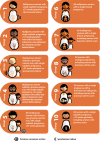Audit and feedback using the Robson classification to reduce caesarean section rates: a systematic review
- PMID: 28602031
- PMCID: PMC5763379
- DOI: 10.1111/1471-0528.14774
Audit and feedback using the Robson classification to reduce caesarean section rates: a systematic review
Abstract
Background: In most regions worldwide, caesarean section (CS) rates are increasing. In these settings, new strategies are needed to reduce CS rates.
Objectives: To identify, critically appraise and synthesise studies using the Robson classification as a system to categorise and analyse data in clinical audit cycles to reduce CS rates.
Search strategy: Medline, Embase, CINAHL and LILACS were searched from 2001 to 2016.
Selection criteria: Studies reporting use of the Robson classification to categorise and analyse data in clinical audit cycles to reduce CS rates.
Data collection: Data on study design, interventions used, CS rates, and perinatal outcomes were extracted.
Results: Of 385 citations, 30 were assessed for full text review and six studies, conducted in Brazil, Chile, Italy and Sweden, were included. All studies measured initial CS rates, provided feedback and monitored performance using the Robson classification. In two studies, the audit cycle consisted exclusively of feedback using the Robson classification; the other four used audit and feedback as part of a multifaceted intervention. Baseline CS rates ranged from 20 to 36.8%; after the intervention, CS rates ranged from 3.1 to 21.2%. No studies were randomised or controlled and all had a high risk of bias.
Conclusion: We identified six studies using the Robson classification within clinical audit cycles to reduce CS rates. All six report reductions in CS rates; however, results should be interpreted with caution because of limited methodological quality. Future trials are needed to evaluate the role of the Robson classification within audit cycles aimed at reducing CS rates.
Tweetable abstract: Use of the Robson classification in clinical audit cycles to reduce caesarean rates.
Keywords: Audit and feedback; Robson classification; caesarean section; clinical audit cycle; systematic review; ten-group classification.
© 2017 The Authors. BJOG An International Journal of Obstetrics and Gynaecology published by John Wiley & Sons Ltd on behalf of Royal College of Obstetricians and Gynaecologists.
Figures
References
-
- Khunpradit S, Tavender E, Lumbiganon P, Laopaiboon M, Wasiak J, Gruen RL. Non‐clinical interventions for reducing unnecessary caesarean section. Cochrane Database Syst Rev 2011;(6):CD005528. - PubMed
-
- Hartmann KE, Andrews JC, Jerome RN, Lewis RM, Likis FE, McKoy JN, et al. Strategies to reduce cesarean birth in low‐risk women. AHRQ Publication No. 12(13)‐EHC128‐EF2012. - PubMed
-
- Shaw D. National Institute for Clinical Excellence. Principles for Best Practice in Clinical Audit. Abingdon: Radcliffe Publishing, 2002.
-
- Chaillet N, Dumont A. Evidence‐based strategies for reducing cesarean section rates: a meta‐analysis. Birth 2007;34:53–64. - PubMed
Publication types
MeSH terms
Grants and funding
LinkOut - more resources
Full Text Sources
Other Literature Sources
Medical
Molecular Biology Databases


